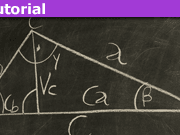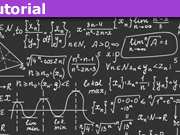How to Self Study Geometry for Students
Geometry is one of the oldest parts of mathematics. It has been studied and advanced by the greatest minds humankind has to offer. It has been described as a subject of great beauty. How do we approach such an amazing work of art as a student?
In this section, I will attempt to give you a basic road map towards pure geometry. I assume that you are familiar with high school geometry and trigonometry. If not, you should see my guide on how to self study high school stuff.
Geometry is a huge subject, and there are a lot of classical works on geometry. Not all of these classical works have survived the test of time. The works of Apollonius and Archimedes are very beautiful but are much easier to study with modern language and modern notions, such as analytic geometry and calculus. Nevertheless, the history of geometry is important if one wishes to understand geometry today.
In modern times, pure geometry is very much neglected in the curriculum. Students go directly to the many related fields of algebraic geometry, differential geometry, topology, finite geometry, etc. I find this a very sad state of affairs since I feel it is quite impossible to appreciate these subjects without a decent grounding in pure geometry or its history. I have seen many students trying to learn algebraic geometry without having any idea of the classical notion of a projective space. This is a shame. As you will see in this guide, I think pure geometry is very important to know as a mathematician, even if you are eventually interested in a more modern type of geometry.
Where do we start learning pure geometry? Let’s start with a timeless book that almost any mathematician in history has read: Euclid’s Elements.
Table of Contents
Euclid’s Elements and Hartshorne’s Geometry: Euclid and Beyond
Euclid’s books are truly wonderful. They mark the beginning of mathematics itself and geometry in particular. Much of the book can still be read very easily today, even though the books are millennia old. Sadly, Euclid does not come without flaws. And while Euclid’s work is timeless indeed, there has been a lot of progress in geometry that shines a new light on Euclid’s results. This is why I think it is important to read Euclid together with a decent commentary. Hartshorne’s book is perfect here. The first chapter guides the reader through the first four books of the Elements and gives some nice commentary on the books. The later chapter presents the results of Euclid in the light of modern geometry. It presents the Hilbert axioms, it gives a modern treatment of area (of rectilinear figures), it deals with hyperbolic geometry quite extensively, and much more.
A possible drawback of Hartshorne’s great book is that there are places where it requires some quite advanced abstract algebra. Now, most of the book is still very readable with only a very modest knowledge of abstract algebra, but it might be that some people wish for a somewhat less advanced book. For these people, I highly recommend Moise’s Elementary Geometry from an advanced standpoint.
If you choose to read Hartshorne, then you should read Hartshorne and Euclid concurrently. In Hartshorne’s book, he will tell you when to read which parts of Euclid. If you choose to go through Moise, then you should first go through Euclid’s first four books and then read Moise’s book afterward for a modern account.
Euclid’s books have many translations. I personally very much like the website by Joyce http://aleph0.clarku.edu/~djoyce/java/elements/ Aside from giving Euclid’s original theorems and proofs, it gives very valuable commentary. If you wish to buy Euclid in book form then I recommend the following book http://www.amazon.com/Euclids-Elements-Redux-Daniel-Callahan/dp/1312110783 It comes with some neat exercises to test your understanding. The book can be downloaded for free legally: http://starrhorse.com/euclid/
Hartshorne’s book can be found here http://www.amazon.com/Geometry-Euclid-Beyond-Undergraduate-Mathematics/dp/0387986502 and Moise can be found here http://www.amazon.com/Elementary-Geometry-Advanced-Standpoint-3rd/dp/0201508672
You will learn the following:
- Classical Euclidean plane geometry
- Construction problems
- The relation between fields and geometries (which is the first step towards algebraic geometry)
- The relation between groups and symmetries (which is the first step towards Lie theory)
- The algebraic solutions to many classical construction problems (Galois theory)
- The classical theory of area
- Hyperbolic geometry
- Platonic solids and other polyhedra
I recommend strongly reading the first four books of Euclid. If you desire, you can read the rest, but I don’t think this is as necessary. The later books have stood the test of time way less (in my very humble opinion). Especially the Greek’s refusal to accept irrational numbers made many later statements in Euclid very very awkward and difficult to grasp.
While reading Euclid’s Elements, you might want to get a more historical perspective on Greek mathematics. For this, I highly recommend the first volume of Kline’s Mathematical Thought from Ancient to Modern Times http://www.amazon.com/Mathematical-Thought-Ancient-Modern-Times/dp/0195061357
Brannan, Esplen, and Gray’s Geometry
After becoming acquainted with Euclidean geometry, it is time to meet some other geometries. A very neat classification of modern geometries has been achieved by Klein’s Erlanger program which connects groups and geometries. This book will treat affine geometry, Euclidean geometry, projective geometry, elliptic (and spherical) geometry, hyperbolic geometry, and inversive geometry. Additionally, it will give a modern (= coordinate-based) treatment of the theory of conic sections both in the affine and in the projective framework. I think a book like this is a must-read for people going into differential or algebraic geometry.
A downside of the book is that most of the exercises are just way too easy. However the main text is excellent, and it’s very hard to find this collection of material in other books. So I still recommend going through the book.
The prerequisites of this book include good knowledge of linear algebra (up to diagonalization of matrices) and some very basic knowledge of group theory.
The book can be bought on Amazon here: http://www.amazon.com/Geometry-David-Brannan/dp/1107647835
After reading this book, you will know of:
- Conic sections and quadric surfaces
- Affine geometry
- Conic sections in affine geometry
- Projective geometry
- Conic sections in projective geometry
- Inversive geometry
- Hyperbolic geometry
- Spherical geometry
- Elliptic geometry
- The unification of all these geometries due to Klein
These two books contain what I think every mathematician should know about pure geometry. But you can continue reading on pure geometry if you want. I suggest the following books if you wish to do so, but the following books are optional.
Bennett’s Affine and projective geometry
In Hartshorne and Moise, you have encountered a relationship between Euclidean geometries and certain ordered fields. The purpose of algebraic geometry is to extend this relationship far more generally. However, it doesn’t require the vast machinery of algebraic geometry to give a relationship between geometries and arbitrary fields. These geometries will necessarily be weaker than Euclidean geometry, but still strong enough to allow many neat results. All of this is dealt with in Bennett’s book. Bennett presents an axiomatic approach to affine and projective geometry and investigates when these geometries come from algebraic objects such as fields.
In this book, you will read:
- An axiomatic approach to affine geometry
- The role of Desargues’ theorem in relating affine geometries to division rings
- The role of Pappus’ theorem in establishing commutativity
- An axiomatic approach to projective geometry
- An introduction to lattices and their relation to geometry
- The fundamental theorem of projective geometry relates geometric collineations to algebraic matrices.
Some modest amount of abstract algebra is required for this book, mainly a basic knowledge of fields. A previous encounter with affine and projective geometry at the level of Brannan is recommended.
Projective and Cayley-Klein geometries by Onishchik and Sulanke
If you liked the unification of the different types of geometries as in Brannan, then this book is a must-read. The book starts with a very high-level approach to projective geometry – using a lot of linear algebra – in the first part. The second part covers the ideas of Klein’s Erlanger program in modern language.
The book can be found here: http://www.amazon.com/Projective-Cayley-Klein-Geometries-Monographs-Mathematics/dp/3540356444
This book is not for the faint-hearted, however. Easier books include the beautiful account by Richter-Gebert Perspectives on projective geometry: A guided tour through real and complex geometry http://www.amazon.com/Perspectives-Projective-Geometry-Through-Complex/dp/3642172857 But I think it’s an absolute shame that the book contains no exercises, which makes it a lot harder to really grasp the material. Another beautiful book is Kowol’s Projektive Geometrie und Cayley-Klein Geometrien der Ebene, which has sadly not been translated into English as of now. http://www.amazon.com/Projektive-Geometrie-Cayley-Klein-Geometrien-German-ebook/dp/B00TZZ95WU
Audin Geometry
If you wish to see all of these pure geometries from a more mathematically advanced point of view, then this book is great. It deals with the usual suspects of Euclidean, affine, and projective geometry; but now the language of topology, analysis, and group theory is used without shame. It’s a perfect follow-up to Brannan’s book for those who are more mathematically advanced. http://www.amazon.com/Geometry-Michele-Audin/dp/3540434984
Advanced education and experience with mathematics








When I taught the first 4 books of Euclid in a 2 week course I wrote some notes for the students. FWIW they are here:
[URL]http://alpha.math.uga.edu/~roy/camp2011/10.pdf[/URL]
They end by showing how Euclid’s ideas are advanced by Archimedes and give a derivation for the volume of a 4 dimensiopnal sphere in that spirit.
It’s obvious that you lost yourself in it. Brain storm every chapter at first. 3 time brain storming will make things like water. And don’t forget to block other thoughts during brainstorming. And more technically ask, question, solve and be patient. Hold and breathe and try to remember what you learned. Good luck….
THANK YOU ! I actually already began reading Euclid but I only completed the first five books.